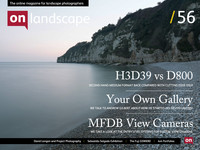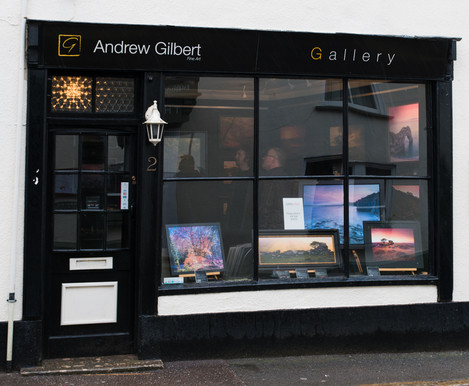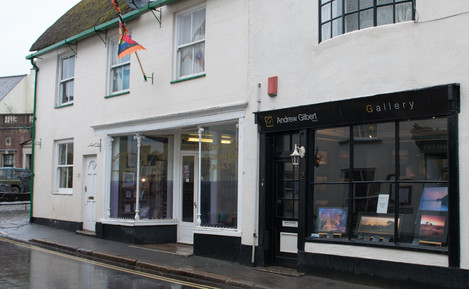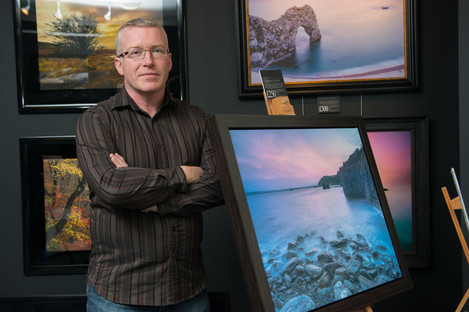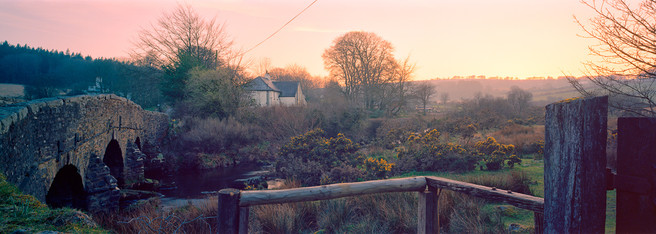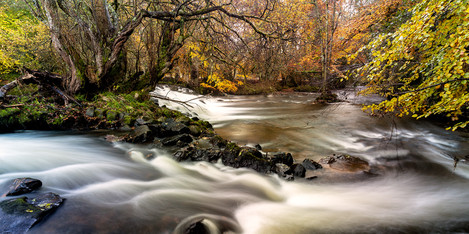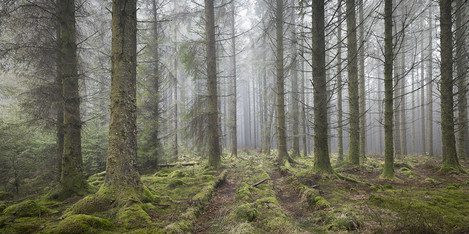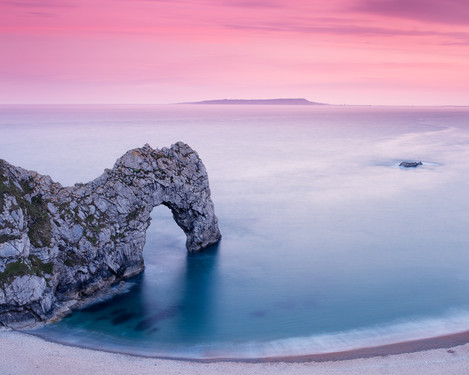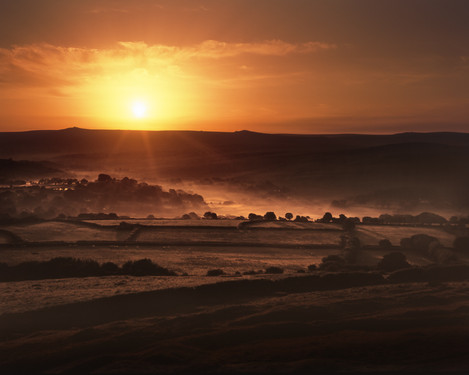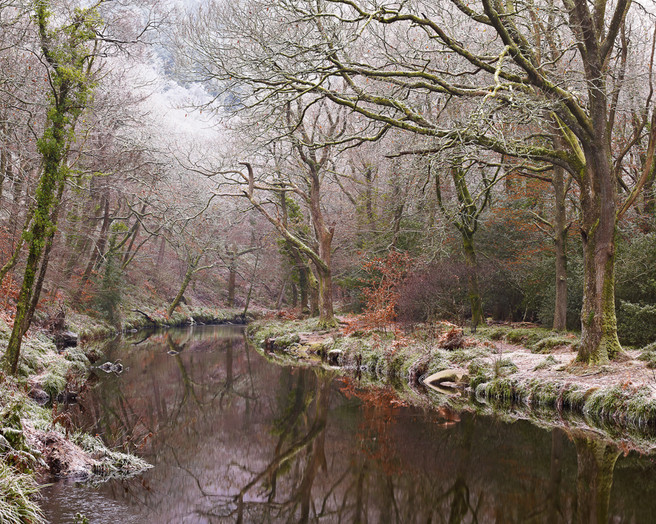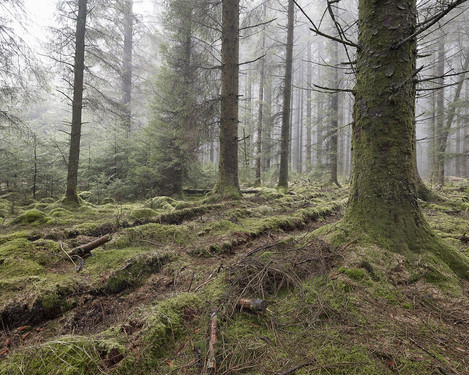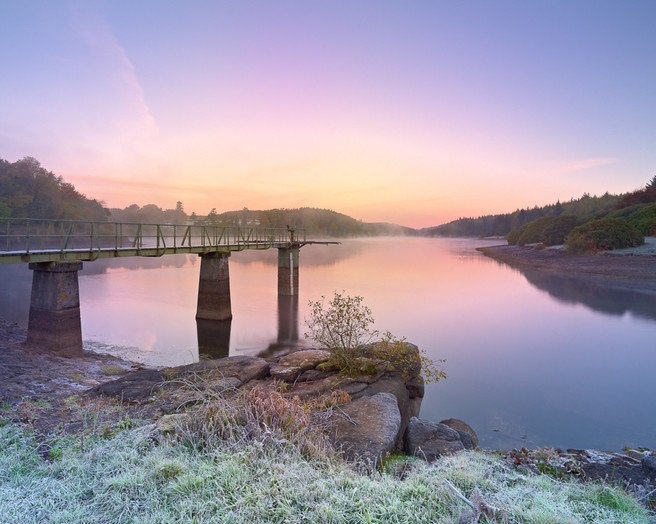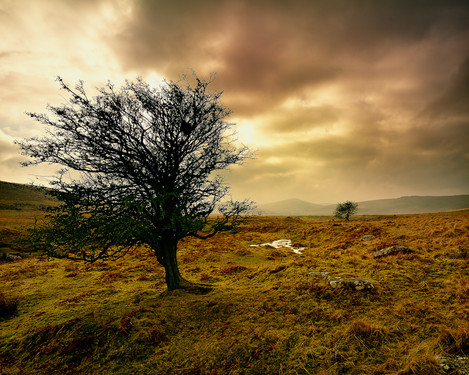An Interview

Tim Parkin
Amateur Photographer who plays with big cameras and film when in between digital photographs.
Whilst on our pilgrimage to Devon last month Andrew Nadolski and I spent a wonderful evening with a bunch of photographers in an Exeter place of beer worship. One of the landscape photographers there, Andrew Gilbert, told us about the gallery that he had opened up nearby and we thought what a great idea it would be to visit and have a chat about how it was to open a gallery and a little but about his photography.
The gallery is in Mortonhampstead and sits just off the main street (Thanks to Andrew Nadolski for the photographs of the gallery and of Andrew Gilbert)
The gallery is small, intentionally so as you will find out when you view or read the interview. Here is a panoramic view of the gallery interior.
TP: Hello and Welcome to OnLandscape. We’re here with Andrew Gilbert in the Andrew Gilbert Fine Art gallery. Can you tell us a little about yourself and the start of the gallery
AG: Well I suppose that the start of the gallery probably goes all the way back to a childhood interest in photography that’s been with me for an awfully long time. From which I made the transition quite a few people make from taking photographs that I liked to taking some that other people liked and then some time about 10-12 years ago people started asking me to actually take pictures for them and wanted to pay for them which was a bit of a new experience really.
So I’d done that on and off for quite a while and we then moved down to Devon about 3 years ago and one of the things I’d always had in mind was that I wanted a gallery [to exhibit pictures in] but I started out with local pubs, restaurants, businesses, the usual sort of finding places photographers find to hang things.
TP: You had been shooting landscapes for quite a while before then?
AG: Oh gosh yeah, 30 years I think, initially with film and then I started to dabble with digital a little bit and then came back to film again and now do roughly half and half.
TP: We’ve got photographs on the website and we’ll intersperse this with some video shots of the exterior, but how did you go about finding somewhere to have a gallery and how did you eventually find this place?
AG: As far as realising there was an opportunity there, I’d had some business trips across to Las Vegas and some business trips. I had lots of other colleagues who enjoyed going out gambling and though I haven’t really got an interest in that I discovered that there are half a dozen landscape photography galleries out there. I spent my time, while everybody else was gambling their money away, wandering around the different landscape galleries and looking at what people are doing and sort of realising that I hadn't really seen anything like this in the UK, but that there were plenty of people in the galleries and the response to the work was positive across a range of photographers.
TP: These were the likes of Peter Lik and Rodney Lough Junior?
AG: Indeed they were so Rodney Lough Junior, Peter Lik, Bill Carr and so on. They all do things that are slightly different but they also have certain elements to their presentation that were pretty consistent really. Coming back to this country I was looking at what I was doing which was, as I say, mostly hanging work in pubs and restaurants at the time, and how I was selling work. People don't go to those sorts of environments to by art though. It’s a completely different level; it’s good to get some feedback on the work, but it’s not such a great place if you want to make money out of selling pictures on a consistent basis. So I took what I’d learned out in the States, pondered it a little bit and thought it would be good fun to do something like that in this country but how could I actually make it work in Britain?
While I was thinking that and looking around at the cost of premises in cities like Exeter and the cost of business rates and trying to work out how you could actually start out and probably have to sell £75,000 worth of pictures before you probably broke even. I was walking through Moreton one day and noticed that this particular unit was up for let and at far more reasonable fees and also discovered that at the moment there are no business rates on a smaller property. So having playing around [and I should probably say that I’ve been involved in quite a few different start-up businesses in the technology sector over the years, so I’d got a vague idea of how to start a business and how to look at the cash flow] with the business plan and looked at the numbers I realised that this was actually feasible at a much, much lower cost of entry than the palatial gallery I would much rather have in a large city somewhere. I'd love to have a gallery like that but I think the reality is if you want to run it as a business, you have to start a lot smaller
TP: It’s probably worth asking, what did you do before? You say you’ve had a few start up businesses, so what’s you’re background?
AG: Other businesses in the technology industry, I’m a mechanical and production engineer by training. I spent the first six years of my life designing bits of sports cars for Lotus and then discovered fairly early on that it was a far more rewarding career working for the companies selling software into that industry - I’ve been involved in 3 or 4 different engineering software start-ups and engineering consultancies.
TP: So the business skills were there as well
AG: The business skills; the understanding of the cash flow aspect of it, understanding the need for a business plan and, the need for marketing certainly, which is something that I think makes or breaks a business. If you look at the galleries in the States, I think their marketing efforts pay back in absolute spades
TP: Yes. Well it has been said that Peter Licks’ rent on an individual gallery in Las Vegas is a $1m a year and that’s a lot to pay back
AG: That’s right, I was told by one of his gallery managers over there that his annual turnover is about $100m, now what his margins are on that is anybody’s guess. He’s allegedly bought his own Durst Lambda (lightjet printer) and so on and there’s not much change out of one of those for a million I don’t think. So he’s got some expensive toys.
TP: Looking around the gallery I’d say you’ve borrowed a few ideas from the Rodney Lough Jr, Peter Lik types in terms of presentation
AG: Yes that’s right, well the big thing that stood out consistently over there was the warmth and the vibrancy of the colours in the prints they were displaying. After a little bit of digging around, I discovered that they were using some very expensive processes – Diasec - acrylic face mounted, which is of course available over here now as well. As soon as I discovered, I thought oh good, I’ve discovered how they are presenting them, I can go and get some prints done the same way. I then discovered how much those things cost to produce which makes it totally impractical, certainly for a small business starting up
TP: Yes, it costs a couple of hundred pounds for the print before you even start selling it
AG: Absolutely, and that’s on top of the £50 - £100 for the C-type print that you actually hand them over to, so you’re talking, for something reasonably sized, £300 or £400 before you’ve put a frame round it and started to cover the overheads of running the gallery, so that was a little bit of a non-starter, especially when we’re in the middle of a recession.
So, what I did instead was really look at why those images were jumping out off the wall in the galleries and listening to what people were saying as they were walking around; trying to understand what was causing people to go in and buy the work and very much the warmth of the colours and the fact that they seemed to glow. Being an engineer I suppose, it’s the always curse, you see something you can’t quite afford and decide you can do it for yourself …
TP: Reverse-engineer that whole process
AG: That’s right, so I found the original patents for the Diasec process, understood that, tried with a quite spectacular lack of success to come up with something that was remotely saleable, recreating the process myself. But reading the original patents, I started to figure out what was actually causing the effects that I was seeing and then came up with a far more cost effective way of doing it, which is all my own and that’s my trade secret.
TP: Well looking around, the thing that stands out in the gallery more than anything is, is the opposite of most art presentation which is you are using black mounts instead of white mounts, and that’s black on the diasec surrounds and also non-glazed, black mounted frame prints
AG: That’s right, partly I wanted something that was my own, so even though I was inspired by what I saw out in the States, I noted that they are all framed all the way to the edges, and I suppose the origins of the black mount are actually Apple. They're to blame for that with the iPad. I was looking at the way pictures appeared in the iPad screen, which of course has the nice big black shiny surround, and I thought well actually that looks really good. With my arty head on at one point I even thought "I wonder if I can get hold of a load of old iPads and just use them as a frame and mount them on the wall?". That idea didn’t last terribly long, but the idea of this black, glossy mount came from the devices people are used to seeing images on when they search websites and well I thought well can I take that to another level, combine it with the printing technique that I’d come up with. So that was where the glossy pieces came from and the response to the black frames which are very contemporary right now, unless you’re in Cornwall in which case they have to be white!
But, certainly if you look around most of the contemporary galleries, black is the overwhelmingly most popular colour and certainly it’s probably 90% of what we sell in here. So finding the colours that worked in the matte presentation I was really looking for - something at a lower price point to engage with people who aren’t necessarily going to spend hundreds of pounds on a picture. I wanted something that was cost effective so I could still make a margin on and that looked like art.
TP: And it’s interesting because you go to most places and they would look in horror at exposing a picture like that to the air with no glass in between it
AG: There is no glass but there’s quite a lot of UV protective varnish there
TP: Yes, you’re putting layers on top of it to protect it
AG: Layers of UV protective varnish, I use inkjet varnishes and actually the mount card also gets a coat to protect it's colour.
TP: But I imagine that’s quite an interesting impact on the people coming into the gallery because they, it’s, they’re not used to seeing things unglazed apart from paintings or canvas
AG: No, that’s right, there are two reactions we get when people walk in, and usually one follows very rapidly after the other. The first remark is “are they photographs or are they paintings?” and as far as I’m concerned, that’s exactly where I want to be, because we are selling it as art. And the second reaction is really to the acrylic pieces, which is “are they lit from behind?”
TP: Yes, where are the batteries
AG: Where are the batteries, is it lit from behind, how’s that done? And once that spark of interest is there, then you’ve got something there to engage with people. They see something that they find interesting, that they want to have because it’s interesting to other people, and you’re on your way to being able to make a sale, and the pictures are kind of important as well obviously!
TP: Now you’ve already said you’ve taken quite a range of different pictures up here and we’ve talked about this at a little meeting we had a couple of days ago. From your point of view having seen the gallery so far, do you see a sort of picture that sells and a sort of picture that doesn’t, have you had enough experience to see that yet?
AG: Yes, it’s quite interesting, probably something to do with the weather we’ve had, possibly recession and things, there’s definitely a feel-good factor that people have in mind when they see a piece. Pretty overwhelmingly they’re going for the warmer colours rather than the cooler tones which I as an arty photographer person tend to prefer. So it’s quite interesting that there is quite a difference between what the average person coming in looking for a piece of art that at the end of the day they want to hang on the wall, they want to enjoy, what they are looking for is something that makes them feel good, you know they don’t really tend to want the cool colours. Some places - offices, more modern houses - maybe the cooler tones work, but the vast majority of people want something that’s going to make them feel good when they look at it and that tends to be the warmer colour tones
TP: Yes, and do people pay a lot of attention to locality, so they’re looking for things that are location based?
AG: Definitely. Absolutely right, you know, again the vast majority of what we sell is taken within 20 miles of the gallery. I’ve got pieces that sell very well in other locations - some of the seascapes and things, but you know in this part of the world people come out here walking
TP: .. they know the location ..
AG: Yes they know the locations, and interestingly enough one of the surprises to me when I opened the business was that I was expecting a fair amount of tourist trade and that that would be the bulk of our business. One of the pleasant surprises is actually we’ve sold more work to people who live in Devon than we have to the tourists. I mean there weren’t that many tourists last year between the weather, the Olympics and the Jubilee and so on. I was absolutely astounded by the number of local people who came in with comments like, oh I grew up near there, I used to play there as a child, no end of people buying pictures as presents, so the actual habits of people buying the pictures has been quite interesting as well.
TP: Yes. And the big questions is, how do you actually manage to go out and do photography while serving a gallery
AG: HaHa, I don’t sleep a lot! Well the gallery is a business so it has to generate an income. I take dramatically less in the way of photographs now than I did before I had the gallery. That is, in terms of making money out of an exercise like this, one of the things that you have to accept really is that you’re going to do less of the photography if you actually want to make it work as a business and that’s probably the thing that will make or break it for a lot of people. You’ve really got to be able to focus on it, so I take a lot less photographs.
For me personally, I don’t take that many anyway. I mean if I spend a whole day out taking photographs and if I’ve taken four images, that’s probably a lot. The way that I tend to work, I’ll probably spend 2 or 3 months if not longer looking for a particular composition, or I’ll find the composition and then I’ll wait for the weather conditions, the lighting, everything to come together the way I want that particular picture to come out, so I’m not terribly prolific in the number of images that I create so that probably helps
TP: Is that reflected in your, in the camera’s that you use?
AG: Absolutely, yeah. I’ve had an obscene collection of them over the years but, these days I’m pretty much settled between a Linhof 617 Series III which I would say quite easily right now is my favourite camera, probably also my heaviest camera! I also have a Phase One P45 back which I predominantly use on a little Horseman SW-D II which has got a Schneider 24mm lens on the front
TP: So reasonably wide shots
AG: Very, very wide but stunning depth of field without the need for movements and on that particular back it just works beautifully well. Both of the cameras are very uncomplicated - without autofocus, without auto exposure - everything’s done with a light meter, the same way I would with an Ebony View camera which I had for quite a few years and I thoroughly enjoyed using. In fact several of the pictures in the gallery were actually shot using that but the Horseman and the Linhof are the, definitely the two cameras that I’ve settled on as my favoured choice.
TP: And how do you get on, because we’ve, myself and Andrew Nadolski is also here at the moment, and we’ve been talking about entry level, medium format cameras in comparison with DSLRs and suchlike. How do you find, you’ve used DSLRs before I presume?
AG: Absolutely, yeah, I’ve gone through the range of Canon, the obligatory 5D, 5DII, 1D Mark III for a while. It, for me, the colour and especially the tonality that I get out of the medium format back I’ve not seen a digital SLR come close to it. It’s not so much about the resolution, it’s just there’s something in the feel of the images, it’s probably a bit of an arty description for what is a scientific piece of equipment effectively, but that’s it,
The 24 mm lens, you know, it’s clockwork. It’s the same as you’d put on a view camera, which is one of the things I like about it. There is something about taking a picture with a camera with a clockwork lens and that, even though it’s got a digital back on the rear end of it. It’s very much that sort of manual approach which I find just makes me feel better about photography. It’s one of those intangible things I think and of course quite simply the quality of that lens is nothing short of stunning. It’s an interesting beast to work with, you have to correct for the colour casts, so shooting a white panel every time you take a picture is a prerequisite, you have to deal with the centre filter issues and things like that and the light fall off
TP: Is this the camera that Horseman got rise and fall on it or is it …. ?
AG: It has just got rise and fall and shift and no tilts, but it
TP: So you can shift, shift stitch a panorama?
AG: You could and I’ve got to be honest, I did a lot of stitching back in my SLR days with products like PTGui which are probably very well known to you. These days I don’t stitch at all. With the Linhof, it’s generally not necessary and actually with the 24mm lens on the P45, I find that I can go as wide as I want to with that format
TP: It’s one of the things we talked about earlier a little bit as well is the fact that people don’t generally buy very large prints in the UK, it’s very much an American thing, so there is a cap on how big a print you can sell
AG: There is, absolutely right, I mean the reason I’m sitting on a sofa in the gallery is because that’s pretty much dictates the size of the majority of people’s ability to hang something, so for sure
TP: And presumably that’s why panoramas work because even though you’ve got the width of the wall, I mean people don’t generally have the height to go with it
AG: They don’t generally have the height although there is - I should probably not give this one away - but there’s an emerging trend I’m hearing from some of the fine art gallery owners to actually invert the panorama on it 90° axis and people have stairways that are waiting for a piece to hang. They work in two orientations and I think panoramas for some reason people seem to click with them more easily, and I’ve actually noticed that the fine art oil painting world is tending toward quite a lot of panoramic views. Whether there’s a trend emerging there I don’t know, or whether it’s just a coincidence, but certainly the panoramic pieces generate an awful lot of interest.
TP: And does, having had the gallery, do you think that’s affected the sort of pictures you want to take, or that you take now
AG: That’s interesting, I think not actually, which is probably a good thing. I think there is a real danger of trying to photograph for what you perceive the market to want, and I think at that point you immediately fall off the cliff of having your own work and your own identity and doing your own thing, I mean it’s one of the reasons why I try not to look too much at other photographer’s work. I prefer to focus on, you know, what interests me about taking a photograph and sort of that essence of being there, and I think if I start trying to second guess what people want, the chances are I’m just going to completely mess it up
TP: Yes, get it wrong and be led by the market down the wrong path at the same time
AG: Yes, that’s right
TP: The look of your pictures, one of the things we asked earlier on was about using colour negative film, I think you use, there’s a real mix of some chrome film and some negative film in here and then digital
AG: Yes
TP: ..but with I won’t say with subdued colours but it’s not the over saturated look that you come to expect of chromes or Fuji Velvias
AG: No, that’s right, I probably have a love affair with Portra, especially the Portra 400 actually which for some reason just, I love the way it scans and I just love it way it looks. There is a little bit of Velvia lurking around in the gallery, although less so these days, but the majority of its Portra, on the film side of things
TP: And your locations for shooting, do you mostly shoot around here, is this you favourite place to work or do you travel much?
AG: I do travel, I’ve done work out in Austria, I love the Austrian Alps, love the mountains having skied out there for quite a few years. I went out there a couple of years ago during the summer and was just astounded by how beautiful it is out there. It changes completely, but it’s actually still very accessible, so I did take a Chamonix view camera and the Horseman off over the Alps, so I have some pieces from out there and I've also done a lot down in Cornwall, I sort of have a long standing love affair with the South West, I’ve been going down to Cornwall as a child since I was, well, certainly too young to talk if nothing else, so yeah I’ve got quite a lot of pieces from down and around there. I used to live up in the Derbyshire Peak District, so I’ve got a collection from round there, the Lake District is obviously an obligatory location.
TP: Did you try to sell any of the Peak District work in the gallery? Padley Gorge?
AG: …. that one, HaHa, yes, and actually that has sold but that’s generally people who come down here on holiday who recognise somewhere from back home, so I’ve, here I’ve really kept it focused quite closely local
TP: And not too many abstracts either, they are all views
AG: I’ve tried some abstracts, I, here, they were an unmitigated disaster
I had a series of half a dozen 12” square abstracts just stand off frames, all aluminium mounted, which I thought looked fantastic, and quite a few people elsewhere, including some of the other galleries had remarked that they liked them. I had some in here when I first opened and I thought oh well I’ve got a little mix but they didn’t work at all, so they’re not here, which I think is one of the other important things, is as much as I don’t want to fall down the path of trying to second guess what people want, and shoot what I think they want, I think the important thing, especially in a small space like this is if something isn’t generating income, if it’s not selling, take it down and try something else.
TP: So whereabouts do you see it going, do you see, in the next year or so, have you got plans to change things
AG: I think for the next year or so - partly we’ll see how the economy goes, partly we’ll see how the summer works - we’ve not quite had a full year of having the gallery open yet. It’s certainly growing in respect of the attention that it’s getting from the surrounding community, as a consequence of opening it for example I write for Dartmoor Magazine now, I’m doing a small column for them, that in turn obviously serves as advertising and Good PR.
The networking thing’s really important, so for me right now an awful lot of what I’m investing my time and effort in and in bringing more people into this space. I would love a bigger space, the staff are continuously telling me we need a bigger gallery, but moving to a bigger gallery means we’ve got to be able to sustain the costs, so for the moment, increasing the footfall to this gallery is key, so a lot of marketing, and I think just continuing to let it settle and not change too much, too quickly
TP: I’ll ask a question one of my sort of hobby horse issues, do you see any perception in the reactions between the digital shots and the film shots?
AG: That’s very interesting, and knowing your reactions to such things for many years, I do. It’s very interesting when a non-photographing member of the public walks in, one of the things I’ve been interested in here since we’ve had the place is to see how people react when I know how the picture’s been created. There is a tendency for everybody to move to the film shots.
TP: Any idea why
AG: I think it’s down to the colour, the tonality, the range of tones, that there’s a warmth or perhaps a trueness to life about the film. It’s a little more alive somehow, again it’s a wonderful arty term, but it’s probably the best way I can describe it. Digital seems to be very, very literal, and that’s great for some subjects, and certainly digital lets me do some stuff with the longer exposure that I couldn’t do otherwise, but for a warm summer afternoon with the sun just going down and all that wonderful tone and warmth that’s in the sky, film just seems to do a better job
TP: Is that neg or Velvia? Are people tending to
AG: I would say in my case I’m probably thinking Portra when I say that and I think it’s just down to that, it’s got a very, very wide, dynamic range, yeah, it’s all there
TP: The natural balance of light across the frame etc.
AG: That’s right, yeah
TP: Well that will annoy a few people!!
AG: Well also I love the Phase back as well it is a joy to use, but at the end of the day, I’ve got to confess I bought the Phase back before I bought the Linhof 617, so I came back to film through that
TP: Yes, they are tools for different jobs. Thank you very much!
and you can see more of Andrew's work at the gallery website andrewgilbertfineart.com.

